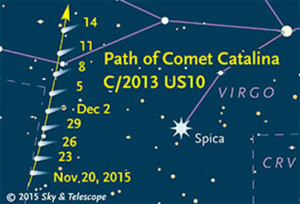Cometa C/2013 US10 Catalina
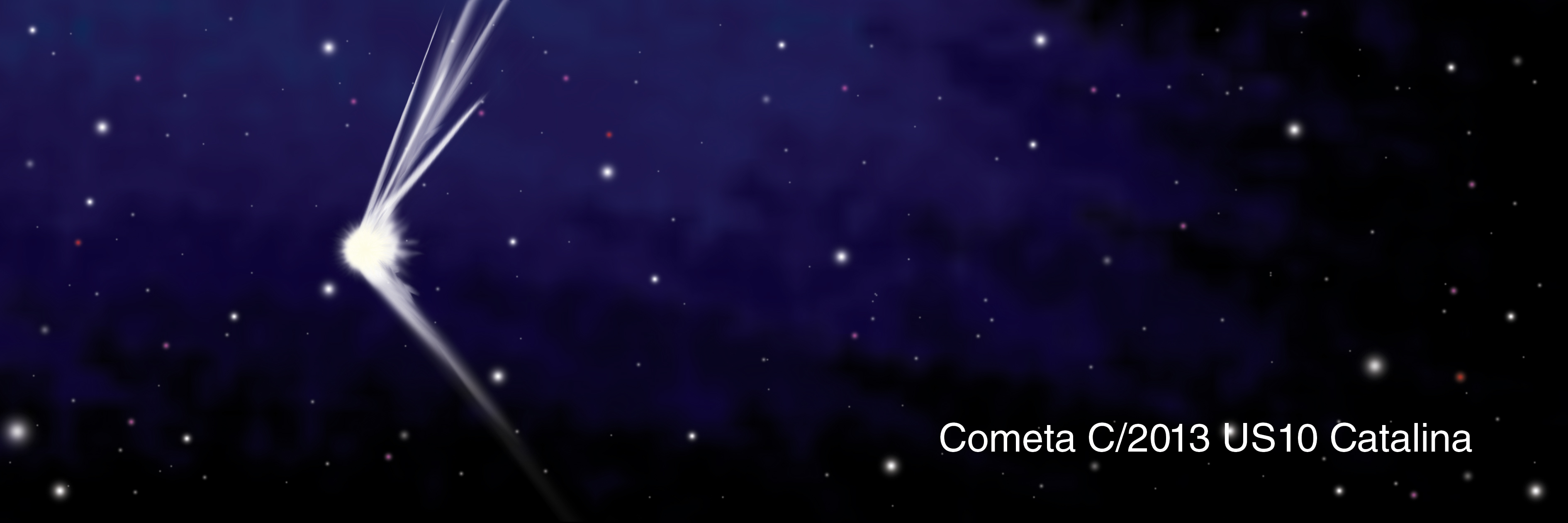
Fecha especial de observación el 7 de diciembre desde las 04:00 de la mañana: Venus, la Luna y el cometa Catalina visible, cuando se encuentre cerca de Venus (aparentemente) a sólo 4 grados de separación esta es la posición aproximada. Es posible ver con binoculares el cometa, que luce espectacular mostrando dos colas!!
Trayectoria aproximada del cometa hasta el 14 de diciembre.
CATALINA COORDINATES
COORDENADAS DEL COMETA C 2013 US10 CATALINA
Fechas A.R. DECL.
2015 12 07 14 18 20.4 -07 48 37
2015 12 08 14 18 14.8 -07 08 42
2015 12 09 14 18 09.4 -06 27 41
2015 12 10 14 18 04.2 -05 45 28
2015 12 11 14 17 59.2 -05 02 00
2015 12 12 14 17 54.2 -04 17 11
2015 12 13 14 17 49.2 -03 30 56
2015 12 14 14 17 44.2 -02 43 09
2015 12 15 14 17 39.0 -01 53 45
Foto y comentario extractado de la página www.spaceweather.com
Picture and report from : www.spaceweather.com
Now that the morning Moon is waning in brightness, amateur astronomers are once again getting a good view of Comet Catalina. Images reveal not one, but two tails. Akihiro Yamazaki sends this picture from Yamanashi, Japan, taken Dec. 4th:
«This is a 36 x 30 second exposure through my 6-inch Astro-Physics telescope,» says Yamazaki. «I used a SONY-A7S digital camera set at ISO 2500.»
Ahora que la luna va camino a Luna nueva su brillo es menor por la madrugada y estamos en la mejor época para observar este cometa, la foto lograda por Akihiro Yamazaki desde Japón el 4 de diciembre muestra las dos colas del cometa. ¨Usé mi telescopio de 6 pulgadas Astro Physics y la cámara SONY A7S digital con ajuste a ISO 2500 con exposiciones de 36×30 segundos.
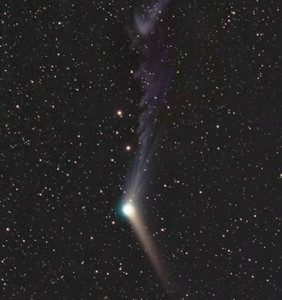
Why does Comet Catalina have two tails? Almost all comets do. The sun-warmed nucleus of a comet spews a mixture of dust and gas into space. Quickly, the mixture separates into two distinct tails: The gaseous «ion tail» is pushed straight away from the sun by solar wind. The weightier dust tail resists solar wind pressure and aligns itself more or less with the comet’s orbit. In Yamazaki’s picture of Comet Catalina, the ion tail points up; the dust tail points down.
Por qué Catalina tienen dos colas?? Casi todos los cometas las tienen, cuando se calientan por efecto de su acercamiento al Sol los cometas emiten gases y polvo, rápidamente estos gases y polvo se separan formando dos colas , la cola de gases o iónica apunta en dirección opuesta a la dirección del Sol por la presión del viento solar, la cola de polvo resiste a la presión del viento solar y se alinea siguiendo aproximadamente la trayectoria de órbita del cometa siguiendo leyes de mecánica celeste orbital.
This is Comet Catalina’s first visit to the inner solar system–and its last. The comet’s close encounter with the sun in mid-November has placed it on a slingshot trajectory toward interstellar space. Although the comet is leaving the solar system, it will become easier to see in the weeks ahead as it approaches Earth. At the moment the comet shines like a 7th magnitude star–invisible to the naked eye. It could brighten by one or two magnitude by mid-January. Sky maps and observing tips may be found in this article from Sky and Telescope
Esta es la primera visita de Catalina al interior del Sistema Solar su mayor aproximación al Sol se dio a mediados de noviembre y ahora es impulsado por la atracción solar a un viaje de retorno al exterior del Sistema Solar, actualmente se aproxima a la Tierra siendo más visible hasta mediados de enero de 2016
A date of special interest is Dec. 7th when the comet pairs up with the planet Venus and the waning crescent Moon in the early morning sky. Catalina will be about 4odegrees away from the Venus-Moon combo. Stay tuned for more information about that, and meanwhile browses the realtime comet gallery for sightings.
Una fecha especial es la del 7 de diciembre cuando el cometa se encuentre cerca de Venus (aparentemente) a sólo 4 grados de separación esta es la posición aproximada. Es posible ver el cometa con binoculares! Inténtalo!! Dato tomado de: http://earthsky.org/tonight el cometa actualmente tiene magnitud 7.
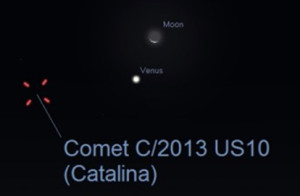
Recommended Posts
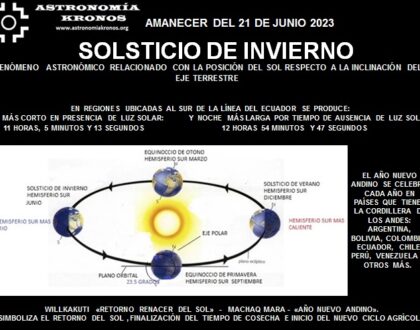
SOLSTICIO DE INVIERNO – AMANECER DEL 21 DE JUNIO 2023 -FENÓMENO ASTRONÓMICO RELACIONADO CON LA POSICIÓN DEL SOL RESPECTO A LA INCLINACIÓN DEL EJE TERRESTRE
junio 20, 2023
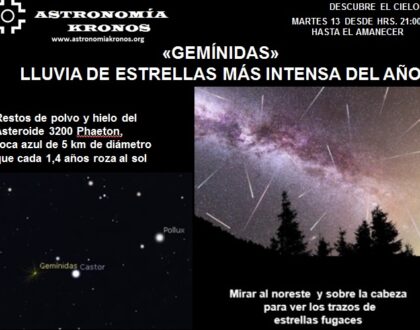
OBSERVA EL CIELO – HOY MARTES 13, GEMÍNIDAS LLUVIA DE ESTRELLAS MÁS INTENSA DEL AÑO – DESDE HRS. 21:00 HASTA EL AMANECER
diciembre 13, 2022
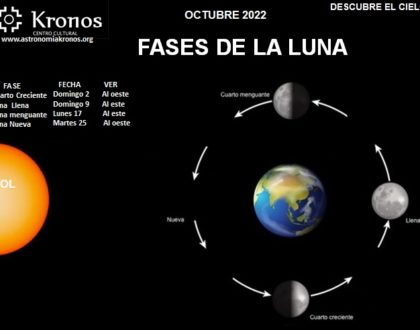
DESCUBRE EL CIELO – FASES DE LA LUNA – OCTUBRE – 01 DE 2022
octubre 01, 2022

